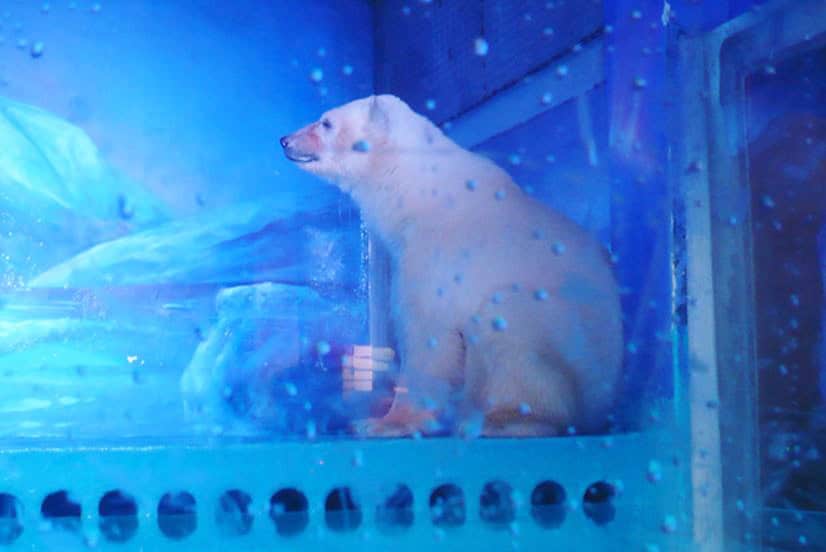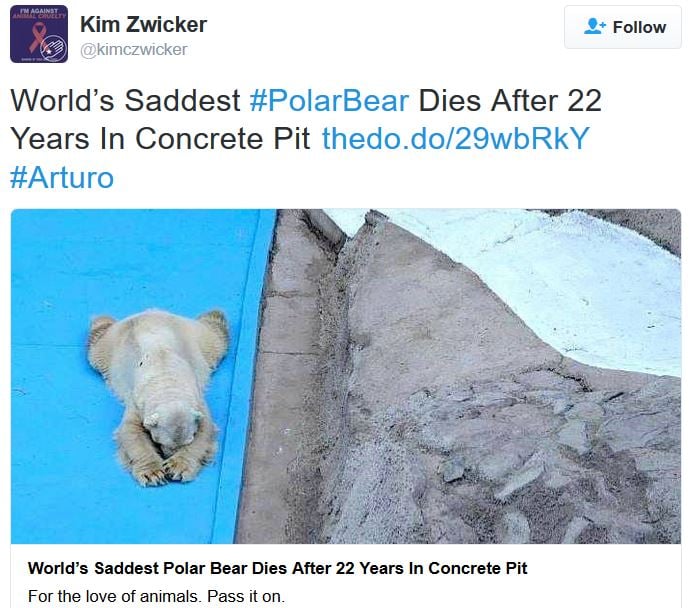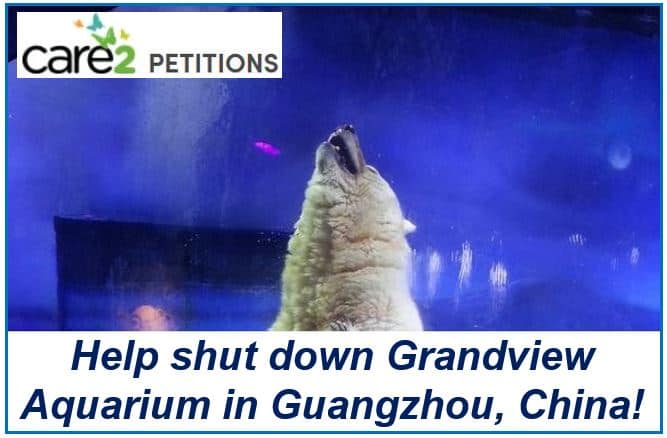The world’s saddest polar bear suffers dreadful conditions in a substandard enclosure within a shopping centre in Guangzhou, China, as over 150,000 people sign a petition urging the zoo to shut down. Animal death rates are said to be alarmingly high in the zoo as the animals try to survive in atrocious conditions.
According to animal rights activists, the miserable polar bear has an unbearable life in the Grandview shopping centre so that passersby and shoppers can take selfies with the animal and bang at its window all day.
Witnesses say that the polar bear, which clearly shows signs of extreme captivity stress and what appears to be depression, lives in a tiny space with nothing to remind it of its natural habitat.
 According to peta.org, the Grandview Aquarium in Guangzhou, China, is known by many as ‘one of the saddest zoos in the world.’ Its animals suffer from poor care, neglect, lack of stimulation, and no natural light. The zoo is funded by the largest operator of ocean parks in China, Haichang Ocean Park Holdings Ltd. (Image: peta.org/action)
According to peta.org, the Grandview Aquarium in Guangzhou, China, is known by many as ‘one of the saddest zoos in the world.’ Its animals suffer from poor care, neglect, lack of stimulation, and no natural light. The zoo is funded by the largest operator of ocean parks in China, Haichang Ocean Park Holdings Ltd. (Image: peta.org/action)
Animals Asia urges locals to boycott the zoo
The attraction needs to be shut down urgently, says Animals Asia, and is pleading members of the public to boycott the place.
Animals Asia says there is no excuse for any animal to be trapped the way this polar bear is. Zoo experts agree that polar bears are one of the most difficult animals to provide for in captivity.
As captivity restricts the animal’s natural instincts, including its need to forage, the polar bear often exhibits ‘sterotypic’ behavior.
 Earlier this month, Arturo, another polar bear also dubbed the ‘world’s saddest’, died at the age of 30 after 22 years in captivity in Mendoza, Argentina. His living conditions made him literally go ‘insane’. In June, the zoo closed its doors to visitors after 64 animals died, which officials said were due to overcrowding and bacteria. (Image: twitter.com/kimczwicker)
Earlier this month, Arturo, another polar bear also dubbed the ‘world’s saddest’, died at the age of 30 after 22 years in captivity in Mendoza, Argentina. His living conditions made him literally go ‘insane’. In June, the zoo closed its doors to visitors after 64 animals died, which officials said were due to overcrowding and bacteria. (Image: twitter.com/kimczwicker)
Welfare Director at Asia Animal, Dave Neale, said:
“Polar bears require huge amounts of space. Large enough for them to walk, run, climb and hunt. The list of what they need is very long – to a point whereby you can only really answer that what a polar bear really ‘needs’ is to be free to live life in the wild.”
“This bear has no peace and nothing natural to take comfort in. What’s more, information on how best to try to meet the complex physical and behavioural needs of captive polar bears is freely available and yet this animal has been willfully incarcerated in this way.”
“We are calling on the Chinese public not to attend this attraction. We are calling for it to be closed down. This is a bear that suffers for what? For selfies? For shopping?”
Is This The Worst Zoo In The World? https://t.co/GnPjN1TSw6 #China is a Hell Hole for Animals#GrandviewAquarium pic.twitter.com/ryuX7KoMCP
— Bri*Ani-Pals UN (@Bri70372823) 2 February 2016
Rumours of many animal deaths at the zoo
The Grandview shopping centre’s zoo has been mired in controversy. The Guangzhou Ocean and Fishery Bureau is believed to be investigating the zoo following rumours that several animals have either been injured or died when being moved into the zoo, often referred to as the Aquarium.
Polar bears in their natural habitat require vast areas of space. It is an excellent swimmer and will frequently swim for several days. One bear is known to have swum non-stop for nine days – a total of 400 miles (687 km) – to reach ice far from land in the frigid Bering Sea. She then travelled another 1,100 miles (1,800 km).
When keeping polar bears in captivity, although providing such vast areas is impossible, the world’s best zoos make sure they have enclosures covering a several acres, unlike the Grandview Aquarium, whose facilities are downright cruel as far as the animal is concerned.
According to Chinese social media posts, animals at the aquarium have died and were subsequently replaced. There is very little or no on-site veterinary care, it is believed.
The polar bear is not the only animal stuck in that tiny aquarium, dubbed ‘the world’s saddest zoo’. It houses a total of two polar bears, arctic foxes, five walrus calves, a wolf, and six young belugas.
 CARE2 Petitions says that the animals at Grandview Aquarium have not only been taken out of their natural habitat, but they are forced to live in prison-like conditions in a gigantic shopping mall, where they never see the light of day, never have a chance to breathe fresh air, never interact according to their nature, and where they have absolutely no stimuli. (Image: petitionsite.com)
CARE2 Petitions says that the animals at Grandview Aquarium have not only been taken out of their natural habitat, but they are forced to live in prison-like conditions in a gigantic shopping mall, where they never see the light of day, never have a chance to breathe fresh air, never interact according to their nature, and where they have absolutely no stimuli. (Image: petitionsite.com)
Chinese netizens have been shaming the facility on social media websites, and have asked members of the public to stay away. Unfortunately, the number of curious visitors has not declined enough for anything drastic and much needed action to be taken.
Many of the animals at the Grandview Aquarium in Guangzhou die in horrific conditions, and those that survive are subjected to a life of extreme misery, and all for the sake of profit and entertainment, says Animals Asia.
Grandview says it is very concerned about the welfare of the animals in its zoo – in April this year it promised to improve the facilities. It announced plans to completely redesign the enclosure after meeting with members of Animals Asia.
Captivity stress in animals
Making sure the welfare of animals in captivity is adequate is extremely challenging, experts say. Earth’s animals have evolved over thousands and millions of years and their behavioural and physiological features have developed in order to thrive in their natural environment.
Evolution has not prepared animals for captivity. Their enclosure may be completely alien to them, with the wrong type of climate, size, diet, terrain and other features.
Many captive animals are unable to have control over their environment, they cannot carry out behaviours that have evolved naturally which enhance their survival prospects and welfare. In captivity, they have to rely on humans to provide for many of their biological, social, physical and other needs.
If an animal’s captive environment does not cater for its species-specific requirements, there is usually a deterioration in both mental and physical health.
According to bornfree.org.uk:
“Similarly, invasive interventions such as the restriction of movement, training using negative reinforcement techniques, being trained to preform unnatural behaviours or making modifications to the normal physiology of animals to reduce risks when handling, can cause severe and lasting distress.”
Abnormal animal behaviour may include stereotypic behaviours – repetitive movements which seem to have no clear function or goal – such as swaying, head-bobbing or circling, bar-biting, and pacing up and down are caused by the frustration of natural behaviour patterns, studies have shown.
Video – World’s Saddest Polar Bear
The world’s saddest polar bear is trapped in the middle of a shopping centre in China with no chance of escape.

Comments are closed.